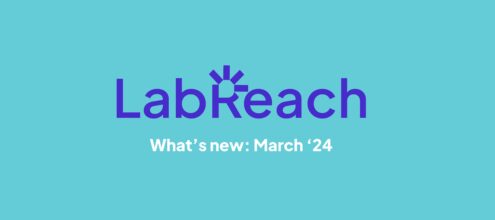New ground is broken under the weight of scale
White paper authored by Jordan Spain, Director of Technology at X-Lab Systems – the world’s leading lab interoperability provider.
The face of technology has changed rapidly in response to the ever-increasing demands of consumers, and the continued growth and aspirations of organisations. What was considered best practice 10 years ago is now outdated, and technologies that were only emerging five years ago are now ubiquitous. Unprecedented scale has been the driving force behind a lot of those changes, where paradigm shifts turn ‘best practise’ into optimising for inefficiency. The Covid-19 pandemic has recently put the world of healthcare (and health tech) on the receiving end of one of these unprecedented jumps in scale. Under the weight of that scale, processes and practices have been bent, some have been broken – here we look at what has emerged from the ashes?
Pathology test volumes increasing exponentially
Every year pathology services in the UK process approximately 1.12 billion tests requested by NHS providers in primary care, community and secondary care[1], and the amount of histopathology requests to laboratories has increased by around 4.5% on average year on year since 2007[2]. The numbers are continuing to increase, and a pressurised NHS is having to adapt as fast as it can to the sheer volume. In January 2022 alone, one of the many peaks of the pandemic, 277.86 million lateral-flow tests for Covid-19 were registered[3].
At X-Lab, we went from processing around one million tests a year to approximately 10 million a day over the span of only a few months at the beginning of the pandemic. Our systems, once fit for purpose, were under immense strain. It forced us to apply unique and novel solutions to bear the weight of that sudden increase – and propelled us through a cloud migration faster than many thought possible.
We went from an on-premise, virtual machine based solution hosted on THIS to a fully cloud native, serverless and elastic solution practically overnight. This was largely due to the heroic efforts and insights of staff – other organisations might not have had the talent density we are fortunate to have. This is the double-edged sword of scale: keep up with the pace and you can entirely transform your product, your processes and even your organisation. Fall behind, or fail to respond, and you can grind to a halt.
Old lab processes not fit-for-purpose
During the pandemic I visited a laboratory that made use of our Labgnostic product to send referral tests to other labs. It was during this visit that I saw first-hand the issues that the pandemic had exposed – a diagnostic machine on one floor was unable to electronically communicate information to another machine on a different floor. The lab staff would print out a readout, take this upstairs and do what they needed to do with this information on the other machine.
This was fine for the lab when it was in the order of 10 times per day, but when the pandemic was at its height, they needed to do this between four and five thousand times per day. This type of scale is what drives the desperate need for better quality of solutions and is what turns once recommended processes into yesterday’s news.
Of course, not every solution is precariously balanced on the edge of a new era of digital transformation. There is little need for a GP surgery to handle billions of patient registrations, nor is there a requirement for dentists to store petabytes of X-Ray images. What the most recent pandemic has shown us, however, is that so many of our digital health systems are disconnected and isolated. Those that are connected have not been stress-tested with any kind of volume that the pandemic presented, and that highlighted so many of the invisible, or ignored, issues. Mounting a unified response of healthcare organisations and systems was done in spite of a lack of interoperability, not because of it.
Pressures of scale creating innovation worldwide
There are plenty of examples of scale in the technology world leading to new paradigms. Netflix for example, is responsible for approximately 15% of all internet traffic[4]. There was no run-book for that level of data – or at least none that weren’t simply optimising a system for a bygone paradigm. They had to build their own technologies and processes to handle this data – and, as a result, have one of the strongest and well respected technology functions in the world, serving roughly 1.5 billion requests in November 2023 alone[5]. They have created and open sourced several libraries such as Zuul, Chaosmonkey (which influenced the entire industry’s understanding of chaos engineering) and more[6].
At Facebook, a lack of appropriate tooling for their web application led to the creation of the React framework, since then it has been open-sourced, which at the time of writing has more than 16,000 commits, almost 2000 contributors and used in almost 20,000,000 (twenty million) repositories on GitHub[7].
Health tech can alleviate NHS pressures
So, what will change in the health-tech world? The entire nation now knows they can take a test at home today and get a test result tomorrow. That notion will only continue to grow, with diagnostics becoming closer and closer to the patient. Can technology alleviate the constant pressure on the NHS by connecting virtual wards and physical hospitals together? If we allowed interoperability between heterogeneous systems, what vulnerabilities and frailties fall out? What sort of information can we extract and extrapolate from?
Pandemic has changed how people interact with healthcare
I predict we’ll see some of the big technology players such as Amazon, who already have one of the world’s largest logistics networks, wade onto the scene and attempt to disrupt it, alongside an increase in direct-to-consumer healthcare. The pandemic has changed the way people interact with their health services; telehealth and diagnosis-via-zoom forever adjusting the way we view the limitations of the application of technology in healthcare. There’s never been a more exciting time to be working in the intersection between healthcare and technology.
Here at X-Lab, we’re very much looking forward to being at the forefront of continued innovation.
Case Study:
X-Lab processed 500 million tests during Covid
At the onset of the pandemic the UK government mandated that all labs would connect to Labgnostic (our National Pathology Exchange (NPEx)) to support the national Covid response. 41 extra labs were onboarded within 6 months to meet this directive and the full program covered all NHS labs. Our solution was scaled to process two million tests/hour and 500 million tests overall.
99.99% availability & outstanding value
Zero unplanned downtime was achieved, with zero clinical safety incidents, and a rapid results turnaround met the huge demands across the service. An 11x financial cost reduction over previous individual lab reporting methods was realised. There were also significant improvements in management control and an incalculable impact on the reduction of the spread of the disease.
More information on Labgnostic
References
1 https://gettingitrightfirsttime.co.uk/medical_specialties/pathology
2 https://www.gov.uk/government/publications/lfd-tests-how-and-why-they-were-used-during-the-pandemic/covid-19-general-public-testing-behaviour
3 https://www.rcpath.org/discover-pathology/public-affairs/the-pathology-workforce.html
4 https://www.sandvine.com/phenomena
5 https://www.semrush.com/website/netflix.com/overview/
6 https://github.com/Netflix
7 https://github.com/facebook/react




